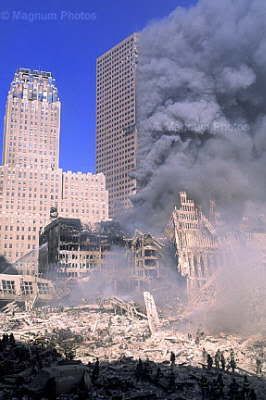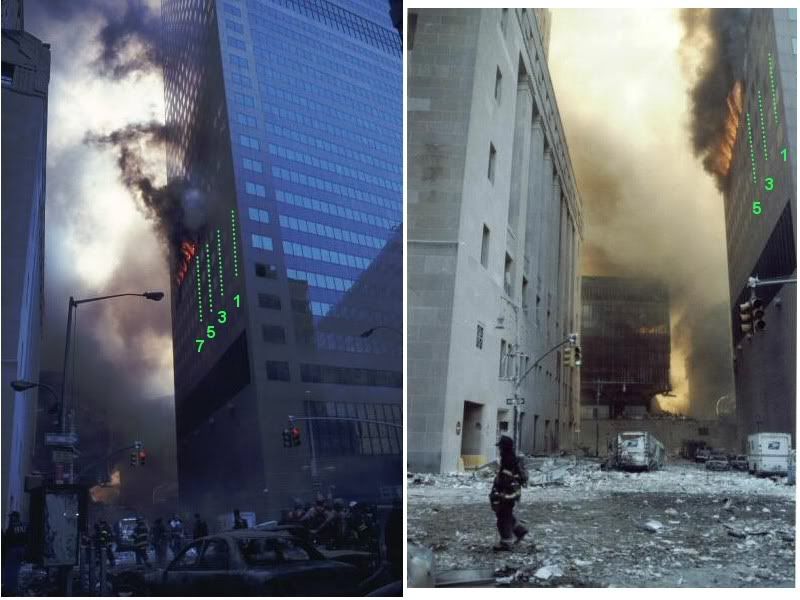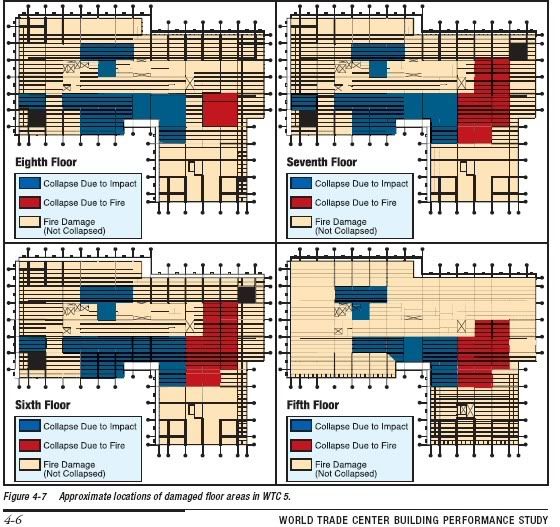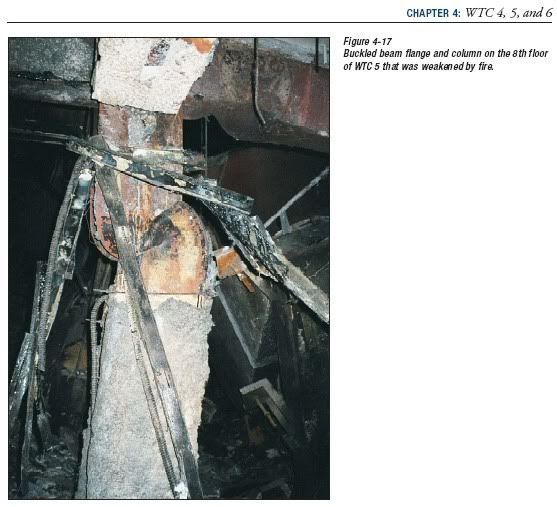2) Were the fires in WTC 7 responsible (either partially or completely) for it's eventual collapse?
As I said in earlier posts, this was the question I believed would be the hardest to research and present. As host pointed out, the NIST investigation is focusing on "normal building fires" as a hypothetical cause for the event. Using that as a basis, I dug into a variety of information, and I struggled with how to present the information in a way that is concise - I don't know if I will meet that goal, but I am going to attempt to boil down the info and interpretation as much as possible - I will try to tie it all together at the end I promise

~~~~~~~~~~~~~~~~~~~~~~~~~~~~~~~~~~
From the Technical Approach Summary of Dec. 18 (
http://wtc.nist.gov/media/WTC7_Appro...c07-Final.pdf), NIST is investigating "fire events" and "hypothetical blast events" as the possible initiating causes of collapse. Since the NIST investigation is not complete, this is presented as a question of "does the [fire events] hypothesis agree with observed events?"
~~~~~~~~~~~~~~~~~~~~~~~~~~~~~~~~~~
a) Time and magnitude of fires in WTC7.
The collapse of WTC1 is thought to have been an initiating mechanism for the fires in building 7. Fire crews were not sent into the building, and as such the fires were free to burn for approximately 7 hours before the ultimate collapse. From the FEMA report fires were known to be on floors 6,7,8,10,11, and 19 (
http://www.fema.gov/pdf/library/fema403_ch5.pdf page 20). Evidence that that fires continued during that time and got bigger:
a1) A picture taken from the southeast sometime after the collapse of the towers. The light reflecting on the east faces of the buildings would point to the time being before noon. Note that there is very little smoke emanating from building 7 (tall building to the right):

a2) A picture taken from the southwest. The light on the west walls indicate that it is later in the day. Note the smoke pouring from the south face of the building. This would indicate that the fires have increased, and also indicates that the wind is blowing from the north to south, so we are not looking at dust from either of the towers, since they are south of building 7.

a3) Two pictures taken from the Northeast at different times (left picture is earlier, noted by the people in the frame, right picture is later, noted by the absence of people in the frame. Note that the fire has progressed toward the north of the building, and note specifically that this is from the East side of the building, the area in which it appears the collapse initiated and caused the penthouse to sink before total collapse ensued.

~~~~~~~~~~~~~~~~~~~~~~~~~~~~~~~~~~
b) Temperature of room/structure fires.
Like Will, I had trouble finding reliable information on temperatures in a structure fire. Since fire heats objects via conduction (flame impingement on object), convection (flame heats air or other meduum which then heats object), and radiation (energy transfers to objects, much like the sun heating asphalt), where do you measure temperature?
b1) We can look at ASTM E119, which is a test adopted intially in 1918 (
http://www.iaei.org/subscriber/magaz...d/berhinig.htm 3rd paragraph) used by building codes in the USA to determine acceptable fire ratings based on a time temperature curve. The curve used by the test presumes a temperature increasing over time that approaches the flame temperature of a fire fueled by typical fuel sources that is not subjected to any sources of cooling, and peaks at 1260 degrees C after 8 hours. Now, no structure fire is a closed system with no cooling mechanism, and building codes recognize this by making the highest rating only need to survive for a 4 hour period of the curve, but it provides us with a starting point as the a maximum theoretical temperature.

b2) Another area to consider is flame temperature. Information on this is more readily available, and a good summary can be found at
http://www.doctorfire.com/flametmp.html
Quote:
Flame temperatures in room fires
There is fairly broad agreement in the fire science community that flashover is reached when the average upper gas temperature in the room exceeds about 600°C. Prior to that point, no generalizations should be made: There will be zones of 900°C flame temperatures, but wide spatial variations will be seen. Of interest, however, is the peak fire temperature normally associated with room fires. The peak value is governed by ventilation and fuel supply characteristics [12] and so such values will form a wide frequency distribution. Of interest is the maximum value which is fairly regularly found. This value turns out to be around 1200°C, although a typical post-flashover room fire will more commonly be 900~1000°C. The time-temperature curve for the standard fire endurance test, ASTM E 119 [13] goes up to 1260°C, but this is reached only in 8 hr. In actual fact, no jurisdiction demands fire endurance periods for over 4 hr, at which point the curve only reaches 1093°C.
|
b3) Fire introduces energy into the surrounding environment, sources of cooling take that energy away. Based on b1) and b2), it is conceivable that in a scenario in which the energy input from the fire exceeds the energy removal from sources of cooling (such as in the interior of a building in which fires had already raised the temperature of exterior members), that the environment can get close to the temperature of the flame if enough time is given, and that would seem to suggest a value from 600C to 1200C (1112-2192F)
b4) The NIST December 2007 advisory meeting included some preliminary fire simulation data in which floor subassemblies were calculated to have temperature regions in the 500-600C range (
http://wtc.nist.gov/media/NCSTACMeet...utes121807.pdf page 6 second paragraph). This value would seem to substantiate the lower temperature boundary in b3).
~~~~~~~~~~~~~~~~~~~~~~~~~~~~~~~~~~
c) Other observations.
c1) WTCs 4, 5, and 6 were also hit by debris, and in the case of building 5, caught fire. None of them globally collapsed the way building 7 did, but the fire damage in building 5 can give an indication as the intensity that building fires can generate. The pictures below are from the FEMA report, Chapter 4 (
http://www.fema.gov/pdf/library/fema403_ch4.pdf)
c1a) Portions of WTC 5 at floors 5 through 8 collapsed due to fire. Note that these regions were in the interior of the building, in locations where we can expect the least amount of cooling mechanisms to be found (fires at the exterior regions would have air as a mechanism for carrying heat energy away and lowering the amount of heat buildup in objects):

c1b) Beams in non-collapsed fire regions of building 5 show sagging, suggesting that the temperature was sufficiently elevated to weaken the steel, although not catastropically as in other regions (yellow arrows are my annotations):

c1c) A picture of a buckled column in a non-collapsed region also show that the fire temperature was sufficient to weaken the steel. The load from this column would have transferred to other columns, otherwise this area would have collapsed as well:

c2) A link Will posted has a graph of load-bearing properties for high-temperature steel as a percentage of strength vs. temperature. From a temperature range of 500C to 900C, the load bearing ability goes from about 70% to 10% of its ability as compared to room temperature. Steel framed buildings are built with a safety factor to account for loss of strength in a fire event, but as the images in c1) show, permanent deformation and partial collapse are still possible.

c3) WTC7's framing was unique in that not all of its columns went straight from the ground to the roof, due to the fact that it had to be build over a substation that already had caissons poured for column support, but at different locations from the eventual building 7 construction. As such, in the area between floors 5 to 7, trusses and girders were used to support columns above floor 7. This construction can be seen as a weak point should a column above floor 7 fail, especially since fires were reported in the area, and is the reason that the NIST hypothesis is that this region failed horizontally after the East penthouse collapsed.
~~~~~~~~~~~~~~~~~~~~~~~~~~~~~~~~~~
Putting together the observations:
- Fires began burning after the fall of the twin towers.
- The fires in WTC7 were not fought by fire fighters, and spread over approximately 7 hours.
- Over time and without sufficient cooling sources (water, air) fire temperatures can weaken steel.
- Available data from testing standards, flame temperatures, and NIST computer modelling indicate that temperatures of at least 500-600C are possible.
- WTC 5 contained regions of collapse due to fire damage in the interior of the building, regions in which cooling sources can be expected to be the weakest.
- WTC 5 showed evidence of steel failure due to excessive temperature, but the loads were distributed to other columns and prevented global collapse.
- WTC7 collapsed internally first, at the East side of the building, an area in which fires were seen to progress throughout the day, and again in an area in which temperature would be expected to be highest due to lack of cooling sources.
- WTC 7 had a unique load distribution scheme in floors 5 to 7 - the columns did not extend straight from the ground to the roof.
- Evidence seems to show that after the East side interior collapsed, there was a delay while the load was redistributed, then the interior collapsed from the East to West, pulling the facade down with it.
Since the NIST analysis is not complete and is only at the hypothesis stage, do these observations provide a likely probability that the fires led to the events that occurred. At this point, I would have to say that they do. If there are other observations/evidence that point to a higher probability, let me know!